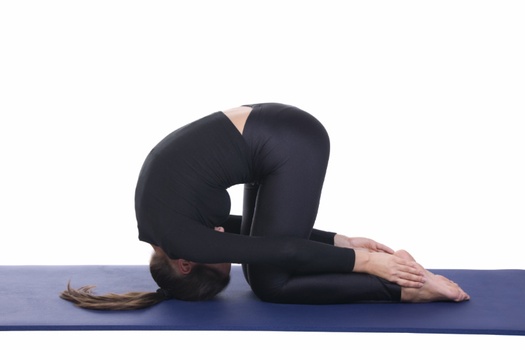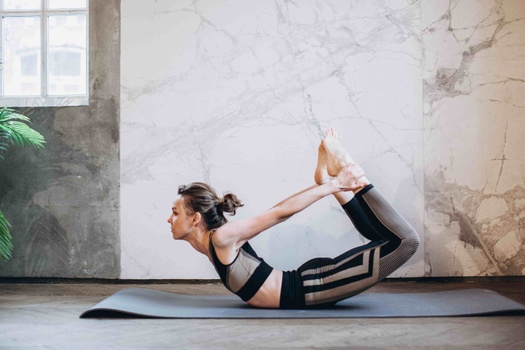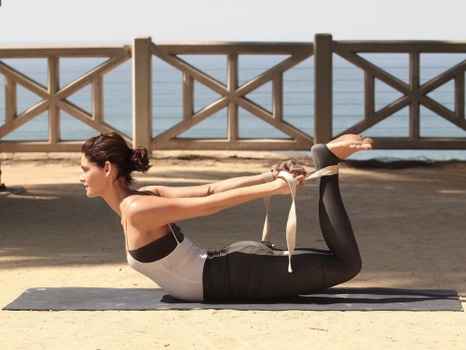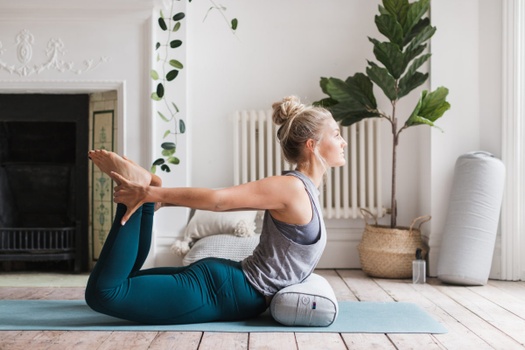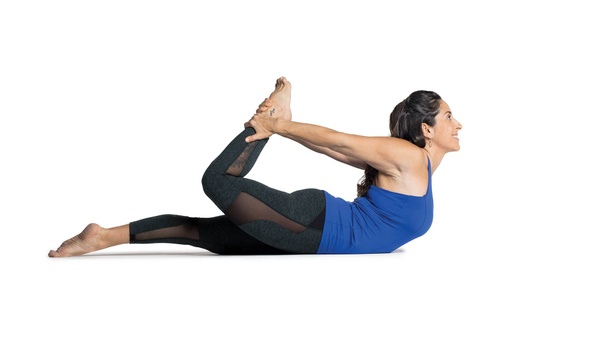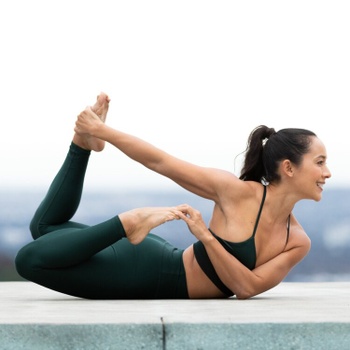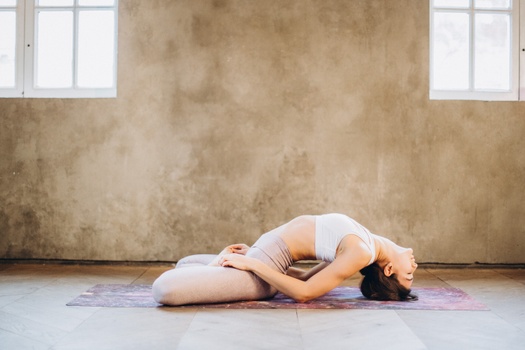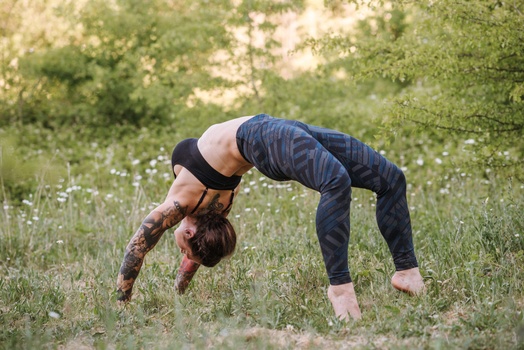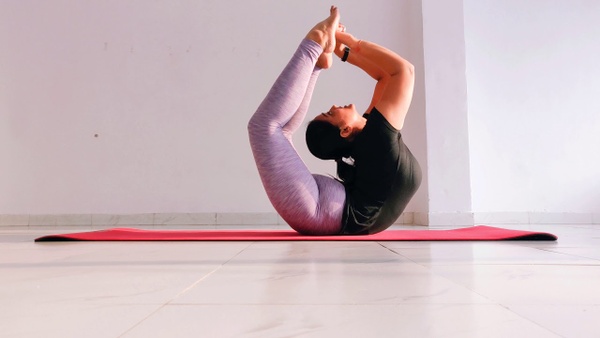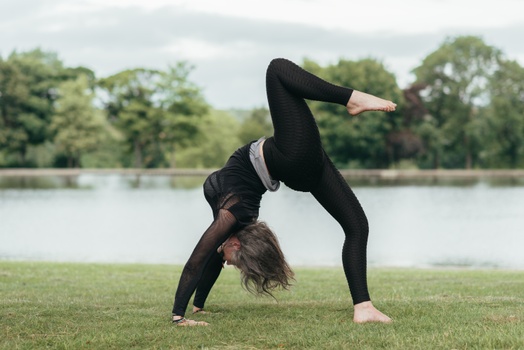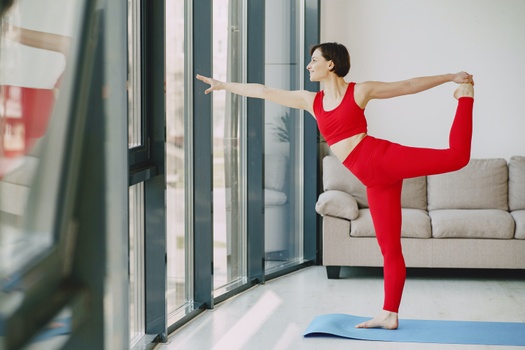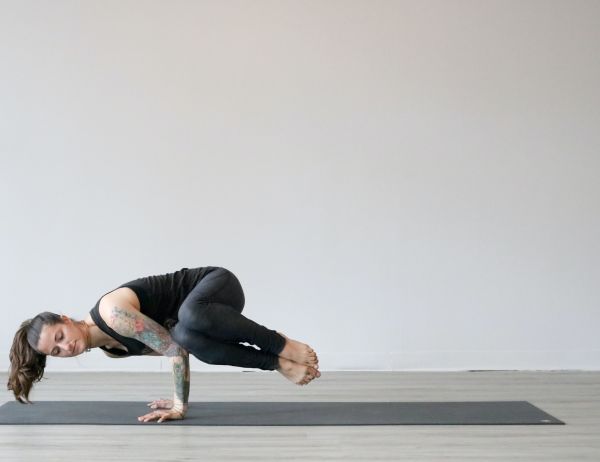Most backbends stretch the lower back the most, but Dhanurasana stretches the entire back and allows you to feel the blood flow if you concentrate on your breathing. Because this stretch is challenging, practicing additional preparatory positions can be beneficial before attempting Dhanurasana.
Part 1 - Preparatory Poses for Dhanurasana
Dhanurasana works on the abdomen, back, glutes, and quads. So, make sure to prepare these targeted muscle groups with increased blood flow altogether. Perform below listed flowing poses for your preparatory warm-up:
1. Makarasana (Crocodile Pose) -
While lying face down in Crocodile Pose, a few stretches for the knees, ankles, lower back, neck, and upper shoulders should be performed.
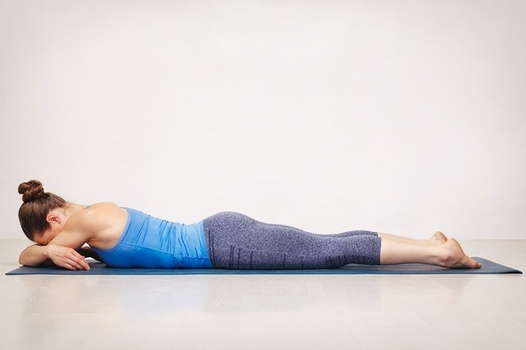
For example, by bringing the feet together and folding the knees, you can rock the lower back left and right. Alternately kick your legs down and up to begin loosening up your thighs and hips
2. Bhujangasana (Cobra Pose) -
This Pose, in which the spine resembles a Cobra's elevated hood, provides the necessary stretch for the lower back. While lying down with your face down, place your palms by curving your elbows close to your upper abs near the chest. The spine is nicely curled, and the neck is taken backward.
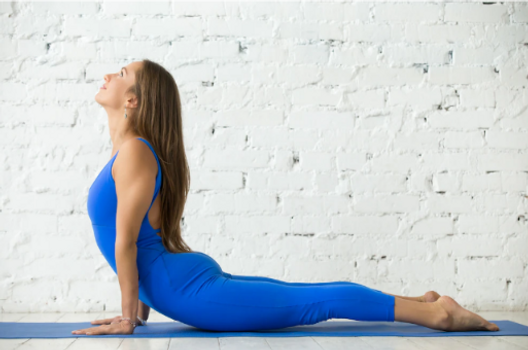
3. Salabhasana (Locust Pose) -
Salabhasana is entered from a prone pose. The legs are straight and lifted; the arms are straight back, palms down, and lifted; and the head is raised with the gaze pointed straight forward.
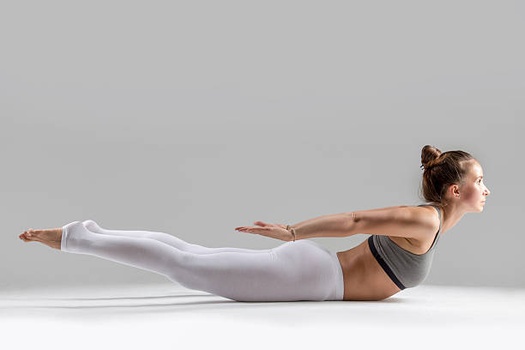
It's a backbend, or spine stretch, in which the upper and middle back muscles work together to lift the legs as high as possible from the floor and hold body weight on your abdomen.
4. Eka Pada Dhanurasana (One-Legged Bow Pose) -
To get into the One-Legged Bow Pose, bend one leg at the knee, grip the ankles and hold for a few minutes.

Eka Pada Dhanurasana is a perfect preparation pose for beginners in the backbends category, this helps newbies systematically understand their bodies before moving to the full version of the backbend.
Part 2: Step-by-Step Instructions to Perform Dhanurasana
Fly like an arrow in this pose designed to strengthen your back muscles and stretch those muscles at the front of your body. These movements can also open the tight muscles of your quads and shoulders and stretch your abs. Here are the following steps:
Step 1- Lie on your belly and extend your legs, with your head slightly lifted off the mat, the tops of your feet flat on the mat, and your arms relaxed at your sides. Face your palms up.
Step 2- Then, bend your knees, reach your arms behind you, and grab your ankles with your hands. To make this easier, grab the outsides of your feet.
Step 3- Press your thighs together and keep your arms stretched.
Step 4- Press your ankles (or feet) into your hands and lift your thighs and chest off the mat, curling your shoulders backward and broadening across your collarbones.
Step 5- Press down through your pubic bone to pull yourself deeper into the backbend. Keep holding this posture for 3 to 5 full breaths.
Inhalation:
Inhale slowly as you lengthen your arms behind you and hold on to your bending legs at the ankles. Keep your forehead on the floor for a few breaths. Make sure the shoulders are firmly settled and that the body is upright and in perfect alignment with the mat.
Raise your head off the floor and take a deep breath, stretching your chest, shoulders, and upper body upwards and rearward while tightening your ankles. Remain here until the body is well-balanced and breathing is normal.
Once the body is at ease, start slow breathing and raise the thighs higher with each inhalation, move the chest and shoulders backward, and exhale in the posture.
Exhalation:
After a few seconds or breaths, slowly inhale and exhale while lowering both knees, shoulders, and chin to the ground while still gripping your ankles. Then relax the neck completely by releasing the ankles and stretching the legs behind you on the floor.
Now lie down in full Makarasana and extend your entire body back to the floor, relaxing. Begin with calm breathing and, as you exhale, focus your attention on your lower back, feeling the stress dissipate as you contract the muscles in and around the spine.
Performance Duration for Beginners: Hold the cobra pose for 20-60 seconds.
Performance Duration for Advanced: Hold the pose for 2 to 6 minutes.
Part 3: Things to Keep in Mind
To avoid injury and maintain appropriate form, it's critical to avoid these common mistakes.
Holding the toes of your feet is not a good idea - Grab your ankles rather than any other foot area when reaching back with your hands. The ankle is the safest area of the foot; however, gripping the feet' tops can cause slipping. If your hands slide, you may lose your equilibrium and hit your jaw or chest on the floor.
Carefully rotate the shoulder socket - Bow Pose demands you to reach back and lift your arm. Throughout the exercise, make sure to rotate your shoulder slowly and cautiously. Rushing through the process to reach and lift your arms can cause injury or discomfort to your shoulder.
Release the Pose with Care - Beginners and practitioners with little flexibility may find Bow Pose challenging to enter and execute. To avoid damage and strain, it's critical to release the pose safely. Release the stance once you've lowered your head, body, thighs, and feet. When specific body parts are raised, releasing the pose can result in a painful impact on the floor. Slowly lower yourself, then release your ankles as soon as it is safe to do so.
Take a deep breath, but don't hold it - Holding your breath is a feature of several yoga positions, and it can be beneficial. Bow Pose does not require you to hold your breath. To get the most out of this stance, make sure you're breathing smoothly. Exhale as you bend into and out of the pose. When you elevate your head, take a deep breath. Holding your breath might make it difficult for your chest to expand.
Part 4: Relaxing Poses After Dhanurasana
Understanding the effects of each yoga stance on the muscles will enable you to instantly follow up with the appropriate yoga pose sequence for relaxation. Because not everyone's body and flexibility are the same, the order will vary. The usual resting positions that can be practiced after Dhanurasana are listed below.
1. Makarasana (Crocodile Pose) / Advasana (Reverse Corpse Pose):
In this stance, you must immediately relax your whole body. With face down on the floor, arms spread in front, and feet placed a foot apart, slowly release the entire body, ensuring the chest and abdomen push the floor while respiring.
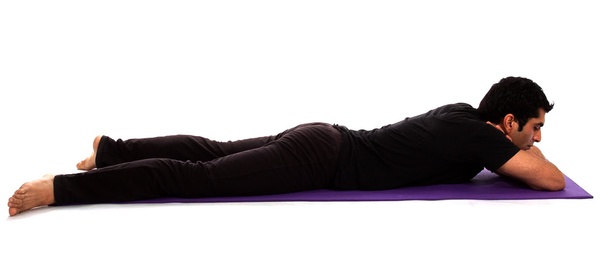
2. Adho Mukha Virasana (Downward Facing Hero Pose):
Downward-Facing Hero Pose can ease the deeper stretch of the shoulders in Dhanurasana. After releasing Dhanurasana, proceed backward and sit on your heels and knees in Makarasana (Crocodile Stance).
Gather up the entire upper body, palms near the chest, and go backward and sit on your heels and knees.
The arms are spread out in front, and the forehead is on the floor. Focus your attention on your neck, shoulders, and chest while breathing deeply in this pose to relax.
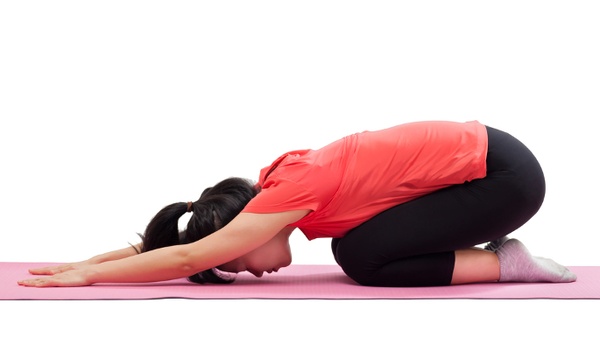
3. Uttana Shishosana (Puppy Dog Pose):
Pick up the body from the lower back and touch the chest on the floor in Adho Mukha Virasana. The arms are stretched forward on the floor, causing the lower back to lift forward as your chest and chin touch the base.
Any strains around the spine generated by Dhanurasana can be relieved by pulling the lower back upwards.
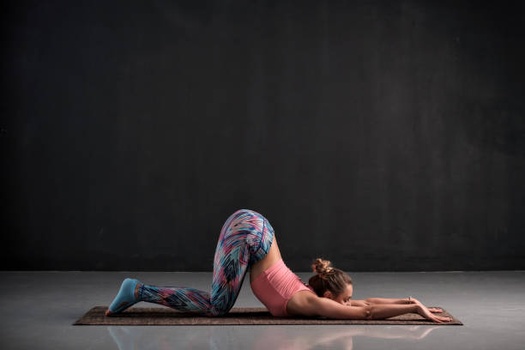
4. Sasangasana (Rabbit Pose):
Lay your arms behind you and attempt to reach for both of your heels while getting your head close to your knees as you transition from Puppy Dog Pose to Rabbit Pose.
The muscles surrounding the neck will relax the more you move the crown of your head down to the floor near your knees. The lower back is elevated, and the entire shoulders and chest are drawn inwards toward the thighs.
